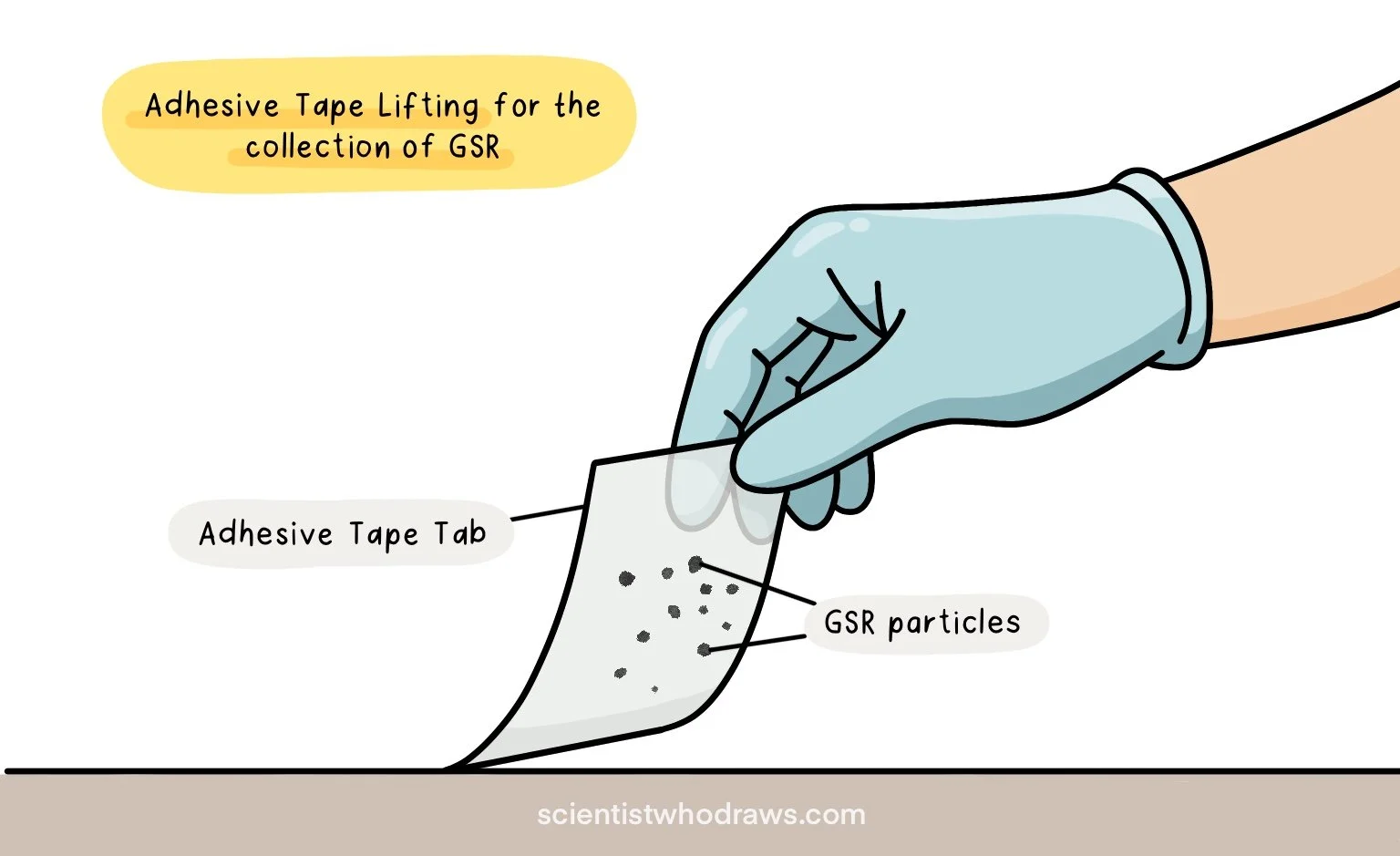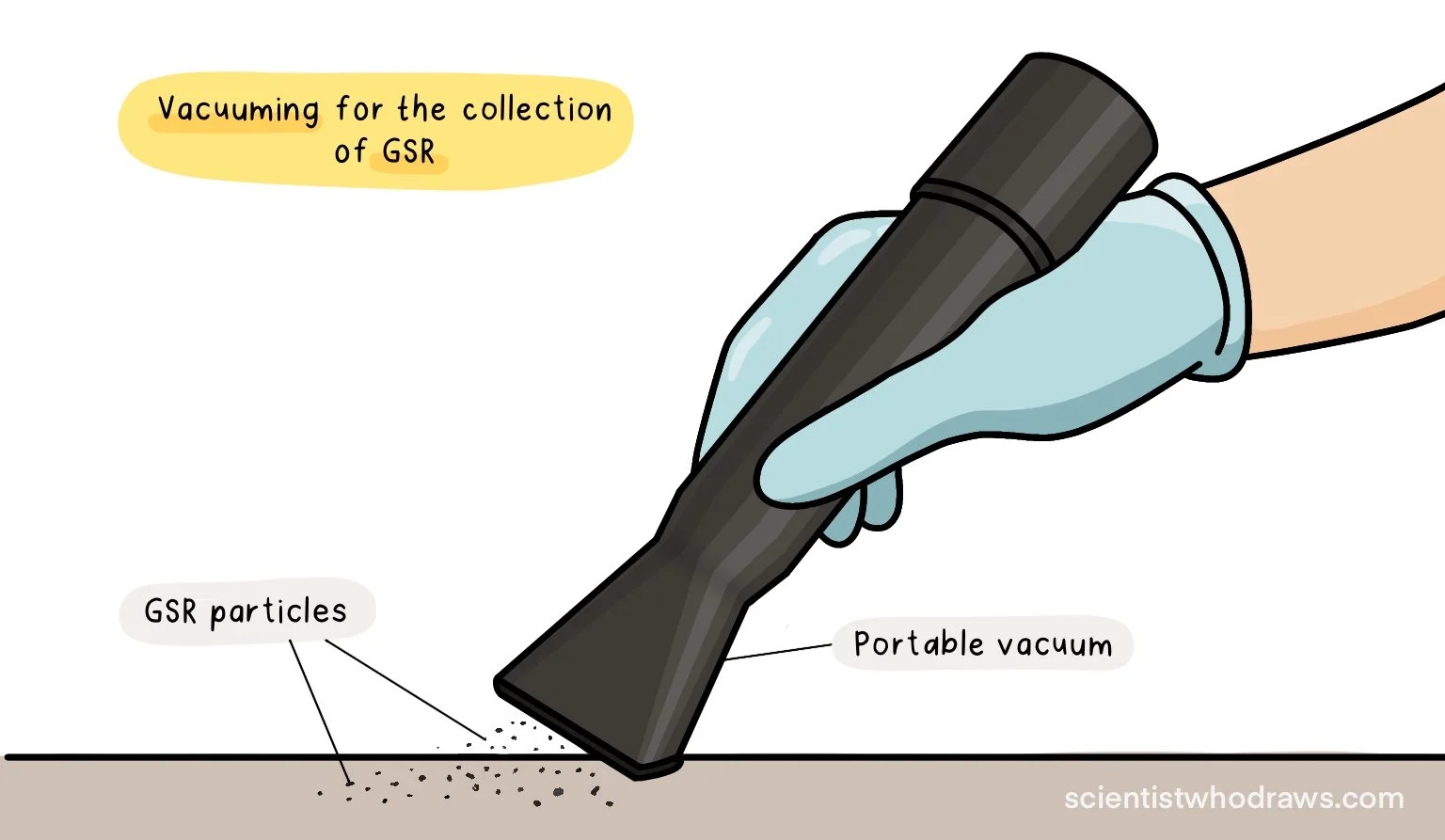Collection and Preservation of GSR
Gunshot residue (GSR) refers to the microscopic particles and chemical traces that are expelled when a firearm is discharged. These particles fall into two main categories: inorganic and organic GSR, based on their chemical composition and source within the ammunition.
Inorganic gunshot residue (IGSR): IGSR consists of microscopic particles containing metals such as lead (Pb), barium (Ba), and antimony (Sb), primarily originating from the primer in a fired cartridge. These particles are relatively stable and can persist on surfaces such as skin or clothing for several hours after a firearm is discharged.
Organic gunshot residue (OGSR): OGSR consists of chemical compounds found in the propellant (gunpowder) such as nitroglycerin, diphenylamine, and other additives. OGSR is more volatile and prone to degradation, making prompt and proper preservation critical.
📌 Read more: Introduction to Gunshot Residue (GSR)
Common GSR Collection Methods
The collection of GSR must be done promptly, as it can be easily lost due to washing, wiping, movement, or environmental exposure. Several methods are used to collect GSR from a suspect, victim, or surfaces at a crime scene, each with its advantages and limitations. Although both IGSR and OGSR are released from the same gunshot, they require different collection techniques because of their distinct chemical and physical properties.
1. Adhesive Tape Lifting
Figure: Methods for Collection of Gunshot Residue (GSR): Adhesive Tape Lifting
Best surfaces: Skin, clothing, dry surfaces
Adhesive tape lifting is one of the most reliable and widely accepted methods for collecting inorganic gunshot residue (IGSR). In this method, carbon-coated adhesive stubs or specially designed tape tabs are pressed firmly onto the surface being tested to pick up microscopic particles.
Advantages: non-invasive, highly specific, high particle retention, minimal contamination risk, and preserves particle shape.
Limitations: ineffective on porous or dirty surfaces and inability to collect organic GSR.
✏️ Note: If both OGSR and IGSR are to be collected from the same surface, tape-lifting (for IGSR) should always be done first. This prevents the dislodging, dissolving, or contamination of inorganic particles caused by the solvents used in OGSR swabbing.
2. Swabbing
Figure: Methods for Collection of Gunshot Residue (GSR): Swabbing
Best surfaces: Skin (hands, face), clothing, and non-porous surfaces such as metal, plastic, or glass.
Swabbing is one of the most commonly used methods for collecting gunshot residue. In this method, cotton or synthetic-tipped applicators are moistened with a suitable solvent to enhance the pickup and solubility of GSR compounds. The choice of solvent depends on the type of GSR being targeted:
1% Nitric acid is typically used for collecting inorganic GSR (IGSR) as it effectively dissolves metallic particles such as lead, barium, and antimony from the skin or fabric.
70% isopropyl alcohol is preferred for collecting organic GSR (OSGR), as it effectively dissolves semi-volatile organic compounds like diphenylamine, nitroglycerin, and ethyl centralite without degrading them.
Swabbing is performed by gently rubbing the moistened swab over areas where GSR is most likely to settle, such as the back of the hands, palms, webbing between the thumb and index finger, and sometimes the face or clothing.
Advantages: non-invasive, cost-effective, and easier to perform.
Limitations: risk of cross-contamination, lower particle retention, and the potential for chemical interference during analysis.
3. Vacuuming
Figure: Methods for Collection of Gunshot Residue (GSR): Vacuuming
Best surfaces: large and uneven surfaces
Vacuum collection is primarily used for collecting inorganic GSR (IGSR) that may be present over large surface areas that cannot be effectively sampled by swabbing or adhesive lifts. This includes car interiors, upholstery, furniture, floors, or walls near the shooting scene. In this method, a portable vacuum device is used with a sterile HEPA filter membrane to trap GSR particles that might be missed by other collection methods. After collection, the contents of the filter can be dissolved in an appropriate solvent like acetone or ethanol. This process helps to extract and concentrate the GSR particles into a liquid form, making it more efficient for lab analysis.
Advantages: suitable for large and uneven surfaces, such as jackets, jeans, and other bulky garments, where residue may be widely dispersed.
Limitations: loss of particle location information, risk of cross-contamination, equipment bulkiness, may collect large amounts of background debris, and potential loss or dilution of particles in filters.
Preservation of GSR Samples
After collection, the GSR samples must be carefully preserved to prevent contamination, degradation, or loss. Proper preservation is crucial to ensure the integrity of the evidence for laboratory analysis and legal proceedings.
Immediate Sealing in Individual Containers: Each sample (such as adhesive stub, swab, or filter) is placed in a separate, clean, labelled container to prevent cross-contamination between samples from different surfaces or individuals.
Labelling: Each container is clearly labelled with the date, time, location, name of the collector, and collection site to ensure traceability and maintain the chain of custody.
Controlled Storage Conditions: Samples should be stored in a cool, dry place, away from heat and direct sunlight, to maintain particle integrity. OGSR samples, in particular, should be stored at 0°C or below in airtight containers to prevent evaporation.
Contamination Control: Collectors must wear clean gloves, changing them between samples, and use sterile tools to handle each item. Samples should be sealed immediately after collection.
Clothing Sample Preservation: It is standard practice to collect the entire set of clothing from a suspect or victim when GSR analysis is required, particularly in cases involving close-range or indoor shootings. Collecting and sealing the whole garment set helps prevent the loss of GSR particles during handling or transport. However, there are a few important considerations to preserve the integrity of the evidence:
Wet or bloody clothing should be air-dried before packaging to prevent mould growth.
Each item should be packaged separately in paper bags or boxes (not plastic) to avoid moisture buildup.
The layering order of garments should be recorded on the evidence tag (For example: “Denim jacket worn over hoodie”) to support accurate reconstruction and analysis.



